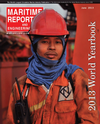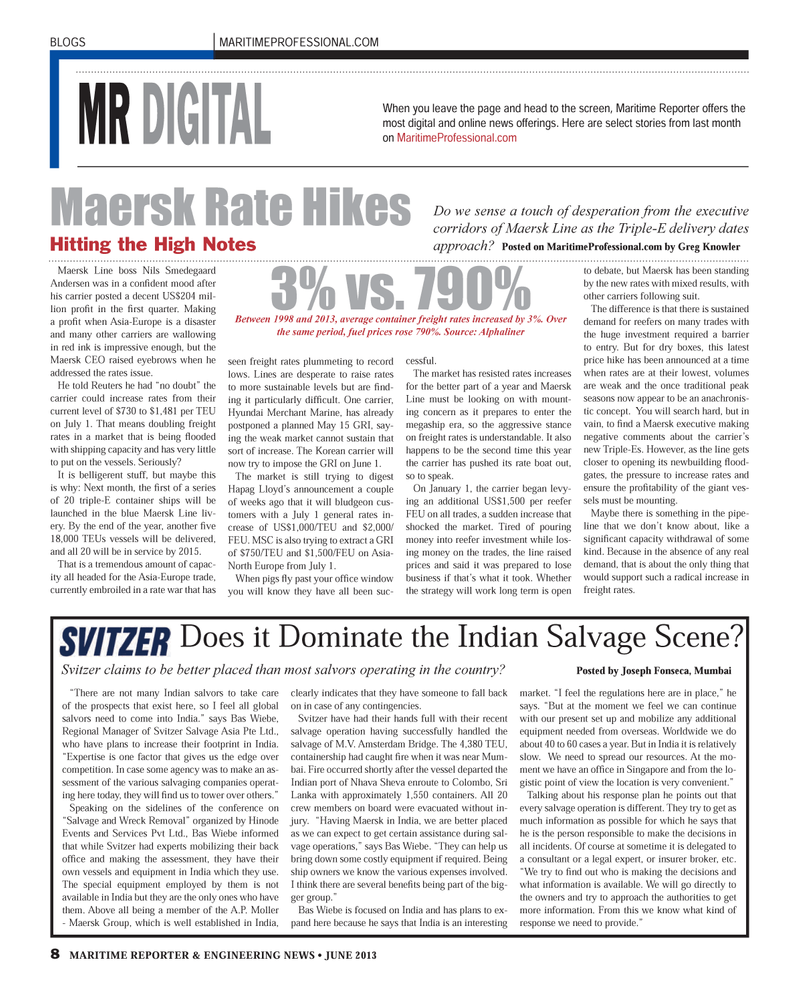
Page 8: of Maritime Reporter Magazine (June 2013)
Annual World Yearbook
Read this page in Pdf, Flash or Html5 edition of June 2013 Maritime Reporter Magazine
8 MARITIME REPORTER & ENGINEERING NEWS ? JUNE 2013 BLOGSMARITIMEPROFESSIONAL.COMMaersk Line boss Nils Smedegaard Andersen was in a conÞ dent mood after his carrier posted a decent US$204 mil-lion proÞ t in the Þ rst quarter. Making a proÞ t when Asia-Europe is a disaster and many other carriers are wallowing in red ink is impressive enough, but the Maersk CEO raised eyebrows when he addressed the rates issue.He told Reuters he had ?no doubt? the carrier could increase rates from their current level of $730 to $1,481 per TEU on July 1. That means doubling freight rates in a market that is being ß ooded with shipping capacity and has very little to put on the vessels. Seriously?It is belligerent stuff, but maybe this is why: Next month, the Þ rst of a series of 20 triple-E container ships will be launched in the blue Maersk Line liv-ery. By the end of the year, another Þ ve 18,000 TEUs vessels will be delivered, and all 20 will be in service by 2015.That is a tremendous amount of capac-ity all headed for the Asia-Europe trade, currently embroiled in a rate war that has seen freight rates plummeting to record lows. Lines are desperate to raise rates to more sustainable levels but are Þ nd-ing it particularly difÞ cult. One carrier, Hyundai Merchant Marine, has already postponed a planned May 15 GRI, say-ing the weak market cannot sustain that sort of increase. The Korean carrier will now try to impose the GRI on June 1. The market is still trying to digest Hapag Lloyd?s announcement a couple of weeks ago that it will bludgeon cus-tomers with a July 1 general rates in-crease of US$1,000/TEU and $2,000/FEU. MSC is also trying to extract a GRI of $750/TEU and $1,500/FEU on Asia- North Europe from July 1. When pigs ß y past your of Þ ce window you will know they have all been suc-cessful.The market has resisted rates increases for the better part of a year and Maersk Line must be looking on with mount-ing concern as it prepares to enter the megaship era, so the aggressive stance on freight rates is understandable. It also happens to be the second time this year the carrier has pushed its rate boat out, so to speak.On January 1, the carrier began levy-ing an additional US$1,500 per reefer FEU on all trades, a sudden increase that shocked the market. Tired of pouring money into reefer investment while los-ing money on the trades, the line raised prices and said it was prepared to lose business if that?s what it took. Whether the strategy will work long term is open to debate, but Maersk has been standing by the new rates with mixed results, with other carriers following suit.The difference is that there is sustained demand for reefers on many trades with the huge investment required a barrier to entry. But for dry boxes, this latest price hike has been announced at a time when rates are at their lowest, volumes are weak and the once traditional peak seasons now appear to be an anachronis-tic concept. You will search hard, but in vain, to Þ nd a Maersk executive making negative comments about the carrier?s new Triple-Es. However, as the line gets closer to opening its newbuilding ß ood-gates, the pressure to increase rates and ensure the proÞ tability of the giant ves- sels must be mounting.Maybe there is something in the pipe-line that we don?t know about, like a signiÞ cant capacity withdrawal of some kind. Because in the absence of any real demand, that is about the only thing that would support such a radical increase in freight rates.MR DIGITAL When you leave the page and head to the screen, Maritime Reporter offers the most digital and online news offerings. Here are select stories from last month on MaritimeProfessional.comMaersk Rate HikesHitting the High NotesDoes it Dominate the Indian Salvage Scene?3% vs. 790%Between 1998 and 2013, average container freight rates increased by 3%. Over the same period, fuel prices rose 790%. Source: Alphaliner Do we sense a touch of desperation from the executive corridors of Maersk Line as the Triple-E delivery dates approach? Posted on MaritimeProfessional.com by Greg Knowler ?There are not many Indian salvors to take care of the prospects that exist here, so I feel all global salvors need to come into India.? says Bas Wiebe, Regional Manager of Svitzer Salvage Asia Pte Ltd., who have plans to increase their footprint in India. ?Expertise is one factor that gives us the edge over competition. In case some agency was to make an as-sessment of the various salvaging companies operat-ing here today, they will Þ nd us to tower over others.? Speaking on the sidelines of the conference on ?Salvage and Wreck Removal? organized by Hinode Events and Services Pvt Ltd., Bas Wiebe informed that while Svitzer had experts mobilizing their back ofÞ ce and making the assessment, they have their own vessels and equipment in India which they use. The special equipment employed by them is not available in India but they are the only ones who have them. Above all being a member of the A.P. Moller - Maersk Group, which is well established in India, clearly indicates that they have someone to fall back on in case of any contingencies.Svitzer have had their hands full with their recent salvage operation having successfully handled the salvage of M.V. Amsterdam Bridge. The 4,380 TEU, containership had caught Þ re when it was near Mum- bai. Fire occurred shortly after the vessel departed the Indian port of Nhava Sheva enroute to Colombo, Sri Lanka with approximately 1,550 containers. All 20 crew members on board were evacuated without in-jury. ?Having Maersk in India, we are better placed as we can expect to get certain assistance during sal-vage operations,? says Bas Wiebe. ?They can help us bring down some costly equipment if required. Being ship owners we know the various expenses involved. I think there are several beneÞ ts being part of the big- ger group.? Bas Wiebe is focused on India and has plans to ex- pand here because he says that India is an interesting market. ?I feel the regulations here are in place,? he says. ?But at the moment we feel we can continue with our present set up and mobilize any additional equipment needed from overseas. Worldwide we do about 40 to 60 cases a year. But in India it is relatively slow. We need to spread our resources. At the mo- ment we have an ofÞ ce in Singapore and from the lo- gistic point of view the location is very convenient.?Talking about his response plan he points out that every salvage operation is different. They try to get as much information as possible for which he says that he is the person responsible to make the decisions in all incidents. Of course at sometime it is delegated to a consultant or a legal expert, or insurer broker, etc. ?We try to Þ nd out who is making the decisions and what information is available. We will go directly to the owners and try to approach the authorities to get more information. From this we know what kind of response we need to provide.?Svitzer claims to be better placed than most salvors operating in the country? Posted by Joseph Fonseca, MumbaiMR #6 (1-9).indd 8MR #6 (1-9).indd 85/31/2013 12:05:14 PM5/31/2013 12:05:14 PM

 7
7

 9
9
